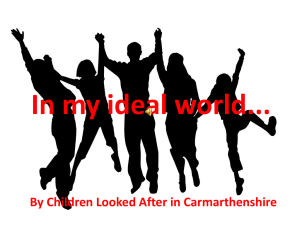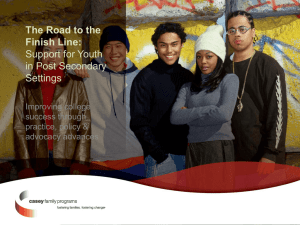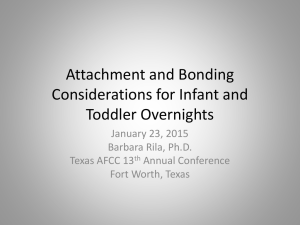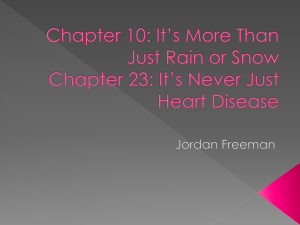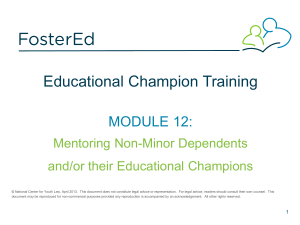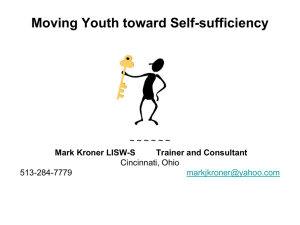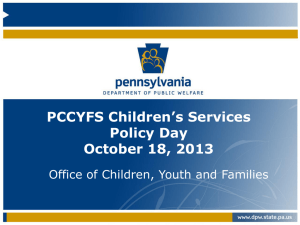Module 3: Young Children in Foster Care
advertisement
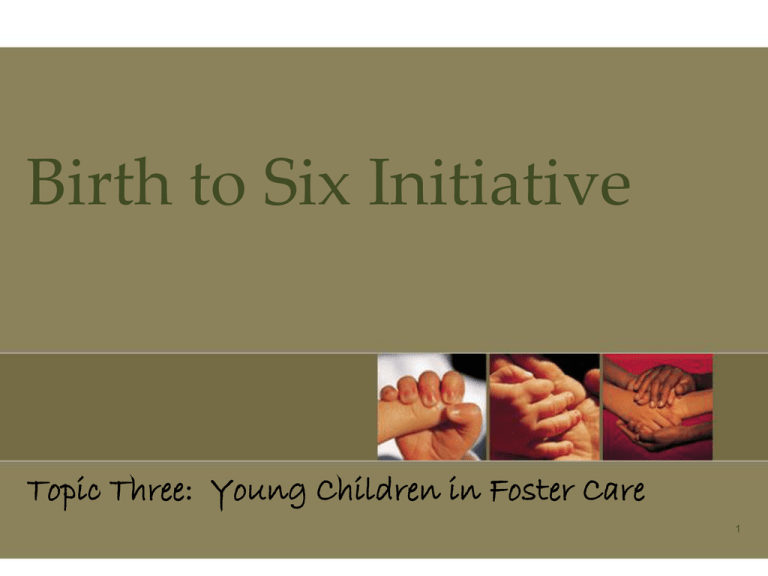
Birth to Six Initiative Topic Three: Young Children in Foster Care 1 Learning Objectives • Learn how foster care is different for young children • Understand the role of the foster parent in the young child’s life • Understand how visitation with young children and birth parents should occur • Be able to create a visitation plan that meets the needs of young children • Value the need for a foster care system tailored for young children 2 What is foster care? • It is an intervention designed to protect and remediate children who have been maltreated. 3 Promote Infant Well Being • Physical Safety – child proofed homes • Provide developmentally appropriate levels of stimuli • Develop positive, nurturing relationships 4 Foster Care for Young Children: Premise #1 •Foster parent must become the primary caregiver and the primary attachment figure for the child. 5 Premise #2 •Safety, stability and emotional availability of the giving adult are paramount. 6 Premise #3 •Foster parents must psychologically invest in the child in order to become the attachment figure. 7 Premise #4 •Adults, but not young children, are capable of sustaining attachment relationships across time and space. 8 Question: •Based on these four premises, how is foster care different for young children? 9 Foster care is different for young children • Cannot sustain attachment relationships over time and space • Require substantial and regular physical emotional availability • No ability to appreciate the big picture of the child welfare system 10 How can foster parents help? • Be sensitive and responsive • Know and value the child as an individual • Place the needs of the child ahead of their own needs 11 Inherent Contradictions of Foster Parenting • Psychological Ownership – Love the child as their own – Advocate for the child – Become the child’s “go to” person in times of uncertainty • Uncertainty – Child can be removed at any time – Progress of biological parents 12 • Isolation/lack of support • Repeated attachments and separation from children in their care • Insufficient or inadequate training • Caring for children who have experienced attachment difficulties • Behavioral or emotional difficulties 13 Institutional care for young children? • Children raised in institutions are at dramatically increased risk of – – – – Disturbances of social relatedness and attachment Externalizing behavioral problems Inattention/hyperactivity Developmental problems 14 Loss for Young Children •What do young children lose when they enter foster care? 15 Loss and Separation •Removal from birth family •Multiple placements •Ambiguous loss 16 Ambiguous Loss “with ambiguous loss, there is no closure; the challenge is to learn how to live with the ambiguity.” Pauline Boss, Ph.D. Ambiguous loss is a relationship disorder and not individual pathology. 17 Two types of Ambiguous loss situations • Type One: Occurs when there is physical absence and psychological presence. – Loss of parent due to divorce or giving up a child for adoption • Type Two: Occurs when there is physical presence but psychological loss – Person you care about is psychologically absent such as autism, depression, traumatic brain injury, dementia 18 How can the foster care system be different? Two Examples • Attachment and Bio behavioral Catch Up (ABC Intervention) – 10 session, manualized intervention delivered by trained clinicians in the home of the foster parent and young child together • Multi Disciplinary Treatment Foster Care (MTFC) • Intense training to foster parents, 24 hour on call staff, daily progress reports • Therapeutic play group, skills training, preschool, family therapy 19 Small Group Activity • Design a foster care system for young children in your county. • What would it look like? • What interventions would be in place? • What outcomes would you hope to see? 20 Facilitating Positive Transitions • Movement of infants should be prevented if possible. • Focus on the infant’s individual developmental needs • Timing is important – Before age 6 months, may be less traumatic than between 6-24 months when attachment is occurring. • Select a caregiver who is willing and able to care for the needs of an infant, i.e. crying, exploration when mobile, “terrible two’s”, etc. 21 Sensitive Transitions • Retain some semblance of continuity – Caregivers should share information about an infant’s needs and preferences – Caregivers should maintain an emotional connection based on their mutual desire for the infant’s well being – Maintain relationship with previous caregivers – Maintain child care settings whenever possible. 22 Retain some semblance of continuity (continued) • Maintain infant routines, including food, formula, sleep schedules • Maintain continuity in diapering, i.e. are they sensitive to temperature when being changed? • Use transitional objects, i.e. special toys, stuffed animals, blankets, music 23 Visitation • Effective visitation creates and optimal opportunity for children and parents to experience being together again. • A high quality visit has a therapeutic goal, incorporates well planned activities to support that goal and is conducted in a developmentally appropriate, interactive manner. 24 Visitation • Why is it important? • Who has the right to visit? • What should happen during visits? 25 The Role of Visitation • Is it harmful? – Stress vs. harm – Includes harm to child’s attachment to foster parent • Is it helpful to the child’s attachment to the biological parent? – What is the goal? • Is it helpful to the biological parents’ attachment to the child? 26 Principles of Visitation • Child’s well being is the primary concern – Must have an attachment figure present if visit more than 6 months old – Better to have an attachment figure present even if less than 6 months old – Child can sustain a relationship with parent without the parent being an attachment figure 27 • As parents progress towards reunification, frequency and length of visits should increase • Relationships with foster parents should continue after reunification whenever possible 28 Things to Remember • Visitation is a child’s right, not a parent’s privilege. • Visitation should never be used as a reward or punishment. • Visitation should be planned and purposeful. • Visitation activities should match the child’s developmental level. • Visitation should occur in as natural a setting as possible. 29 Considerations of collaborative visitation • Visiting without attachment figure (foster parent) causes undue stress on child by second half of first year • Presence of the foster parent can improve quality of visit for biological parent 30 Promising Practices • Ice Breaker Meetings – Provide a structured, first informal meeting early in placement for both foster and birth families to create an atmosphere of “working together”. – This first meeting or “ice breaker” is a facilitated, child focused meeting held shortly after a child is placed (or replaced) in out-of-home care and lasting not more than thirty minutes. 31 Promising Practice: Visit Coaching • Visit coaching and support directly address the issues that brought the child into care, building on family strengths and guiding improved parenting. • Visit coaching begins with an agreement with the family that identifies the child-specific needs to be addressed and an understanding of how those needs relate to the risks that brought the child into care. 32 Visit Coaching (continued) • Before each visit, families work with the visit coach to address fears, barriers, and parenting issues. • During the visit, the coach actively acknowledges the family’s strengths in responding to their child(ren) and guides them in improving their skills. • After the visit, the family and coach evaluate how the next visit could be improved. 33 Small Group Activity • Develop a visitation plan for a child and mother. The mother is making good progress on her case plan and the plan is for reunification in 3 months. Currently visits occur one time a week for one hour. 34 Returning Home • Parents should develop a psychologically and physically safe home • The house should safety proofed • Place “transitional” objects in view of infants to create a “safe” environment • Sing a familiar song, read a familiar book, place former caregiver pictures around the home • Maintain current schedule • Refrain from “overnights” away from the home until adjusted 35 Looking at your County system •What is working well for young children? •What needs improvement? •Prioritize improvements 36 Discussion 37 Post-Test 38 Wrap Up & Next Steps 39
